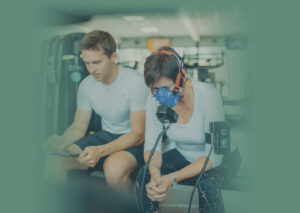If you want to take a closer look at the physical prerequisites for sport and exercise, for example to find out why you are no longer making progress in training, how best to start exercising or simply to find out more about your body, sooner or later you will look for analyses. In this context, you have probably already heard of metabolic analysis. With such an analysis, you should be able to find out more about your health and, among other things, adapt your training optimally to your body.
But is the analysis any good? What types of analysis are there and what are the differences between the methods? We cover these topics, among others, in this blog post.
Spiroergometry vs. lactate analysis
If you want to tailor your training better to your needs, you can Sooner or later, everyone is faced with the question of how to find the right training strategy and training dosage. Two different methods are available for this, which are presented and compared here: Spiroergometry and lactate analysis.
But first - what results should the two analysis methods actually produce?
In addition to determining other important parameters for training, the focus of both forms of analysis is on analyzing the personally suitable pulse and load ranges. The individual anaerobic threshold is determined according to the current fitness level. This threshold represents the exact intensity of exertion at which our body switches from fat to carbohydrate metabolism. With increasing exertion, our body falls more and more into an oxygen deficit, which gradually leads to an over-acidified state. This is not a problem from time to time, because it is also accompanied by adaptations. The decisive factor is the ratio between training sessions with a more relaxed character and more challenging sessions. This ratio naturally differs depending on the person's goal.
And now to the most important question of all: But is it also suitable for normal people or only for really good athletes?
The basic answer is: everyone is different and everyone needs a different dose of exercise and sport. Depending on your current situation. This dosage is determined by metabolic analyses so that, regardless of the goal (losing weight, fit & healthy, body shaping, etc.), our system is neither under- or overloaded. This is the main reason why people are unable to integrate exercise and sport into their lives. They don't realize that in most cases less is more and people tend to train too often and too intensively or not at all.
1. lactate analysis
In most cases, the lactate test involves running slowly at a steadily increasing speed to begin with. Blood is then taken - usually from the ear - to determine the lactate level. The procedure works as follows: when the intensity increases, more lactate is formed than can be broken down in the same time - this increase in lactate can be measured in the blood. The collection of capillary blood should be carried out by well-trained specialists and becomes increasingly difficult as the physical exertion increases. The reason for this is that the body centralizes the blood and draws it from the extremities. Nowadays, lactate values are usually evaluated on site. The translation of the values obtained in lactate analysis is dependent on sports medicine and sports science personnel, as a wide variety of models are used on the market to calculate the individual training zones and the anaerobic threshold. This repeatedly leads to controversial discussions.
2. spiroergometry
Spiroergometry can be carried out on a treadmill or bicycle ergometer. Here, a mask is used to measure the work of breathing and gas exchange via the nose and mouth. In this procedure, the breathing air is analyzed in the course of a step test with increasing exertion. The proportion of carbon dioxide - CO2 - in the exhaled air is particularly important for determining the respiratory compensation point relevant. From this point onwards, a significant increase in the carbon dioxide concentration is noticeable. Due to the increasing anaerobic energy supply, the blood becomes more acidic due to the lactate, which leads to an increased exhalation of carbon dioxide. The respiratory compensation point is therefore comparable to the anaerobic threshold. By determining many parameters from the breath, more compensation mechanisms and influencing variables of the body can be taken into account and the value obtained provides a realistic statement about the physical conditions. A further advantage is that there is no need to take a blood sample to determine the lactate and the spiroergometry evaluation is carried out directly as part of the test.
In recent years, the interest in investigating a person's metabolism at rest and during exertion has spread further and further into popular and amateur sports and even into the health sector due to technical progress and the call for more individuality in training and nutrition.
Conclusion
Lactate diagnostics is now the subject of controversial debate in the camp of sports science and sports medicine, as many different approaches have developed over the years. (threshold value models) of the evaluation, which increases the objectivity of the resulting pulse and load ranges. is in doubt.
In addition, the acceptance of Capillary blood during physical exertion is not easy and requires a high level of expertise on the part of the specialist staff. This is quite different from respiratory gas analysis: by simply putting on the mask and subjecting the test person to standardized stress, we can obtain important information directly.
As briefly mentioned above, lactate determination provides a very good insight into muscle metabolism. However, respiratory gas analysis provides more "systemic" information, as breathing and, above all, the respiratory gas patterns provide a holistic insight into our energy metabolism.
For our analyses, we have developed an independent evaluation system together with the development department of the University of Leipzig. The aim here is to establish independence from the evaluator in the practical interpretation of the results of breath gas analyses, so that objectivity and reliability are ensured both in the first examination and in repeat analyses, i.e. in a before-and-after comparison.
Another major advantage of spiroergometry is its simplicity of use. In comparison to the time-consuming lactate analysis, which is dependent on specialist personnel, the comparison is clearly in favor of respiratory gas analysis, as after the fully automated calibration you only have to make sure that the mask is close to your face.








